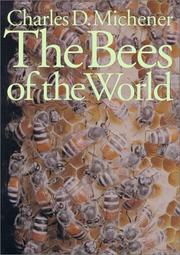| Listing 1 - 3 of 3 |
Sort by
|
Book
ISBN: 9781910389034 9781910389027 191038903X 1910389021 9781472967053 1472967054 Year: 2015 Publisher: London Bloomsbury
Abstract | Keywords | Export | Availability | Bookmark
 Loading...
Loading...Choose an application
- Reference Manager
- EndNote
- RefWorks (Direct export to RefWorks)
Bees are a fascinating and indispensable group of insects, but many species are in decline, and efforts to help determine distributions and changes in abundance have to date been compromised by a serious lack of identification resources. This eagerly anticipated new addition to the highly acclaimed British Wildlife Field Guides series will unravel the complexities of identification, and is designed to cater for people new to the bee world as well as to more experienced recorders who wish to identify every species accurately. It provides the latest information on the identification, ecology, status and distribution of all 275 species of bee in Britain, Ireland and the Channel Islands.
Bees --- Abeilles --- Identification --- Aculeata --- Apoidea --- Bee --- Hymenoptera --- Insect societies --- Nectarivores --- bijen (lt) --- bijensoorten --- Bugonia --- Identification.
Periodical
ISSN: 12979678 00448435
Abstract | Keywords | Export | Availability | Bookmark
 Loading...
Loading...Choose an application
- Reference Manager
- EndNote
- RefWorks (Direct export to RefWorks)
Bees --- Apoïdés --- Abeille. --- Apidé --- Aculeata --- Apoidea --- Bee --- Hymenoptera --- Insect societies --- Nectarivores --- Bees. --- Bugonia --- Apoïdés --- Apidé --- Beekeeping.

ISBN: 0801861330 Year: 2000 Publisher: Baltimore The Johns Hopkins University Press
Abstract | Keywords | Export | Availability | Bookmark
 Loading...
Loading...Choose an application
- Reference Manager
- EndNote
- RefWorks (Direct export to RefWorks)
'The Bees of the World' is the definitive reference work on the 'apiformes.' Written by Charles D. Michener, the world's leading authority on bee systematics, 'The Bees of the World' is the only comprehensive, worldwide treatment of all groups of bees -- 1,200 genera and subgenera, including more than 16,000 species. In extensive introductory sections, Michener examines the evolution of bees from wasps, the relations of the families of bees to one another, the evolution of bees in relation to that of flowering plants, the nesting behavior of solitary and social bees, and the structure of immature and adult bees. Drawing on these considerations as well as the fossil record, he speculates on the attributes of the protobee, the common ancestor of all bees. He also cites the major literature on bee biology and describes the need for further research on the systematics and natural history of bees, including their importance as pollinators of crops and natural vegetation. The greater part of the work consists of an unprecedented treatment of bee systematics, with keys (many of them regional) for identification to the subgenus level. For each genus or subgenus, Michener includes a brief natural history describing geographical range, number of species, and noteworthy information pertaining to nesting or floral biology. The work is beautifully illustrated with 48 color photos of bees, and more than 500 black and white drawings and photographs that depict behavior, detailed morphology, and ecology."At least since the time of Aristotle people have been interested in bees because they are fascinating creatures. We are social animalssome bees are also social. Their interactions and communications, which make their colonial life function, have long been matters of interestwe wonder how a tiny brain can react appropriately to societal problems similar to those also faced by other social animals, such as humans." -- from 'The Bees of the World'
Apidae --- Reproduction --- reproduction --- Biogéographie --- Biogeography --- Identification --- identification --- Taxonomie --- taxonomy --- Bees --- reproduction. --- identification. --- Aculeata --- Apoidea --- Bee --- Hymenoptera --- Insect societies --- Nectarivores --- Bugonia --- Morphologie
| Listing 1 - 3 of 3 |
Sort by
|

 Search
Search Feedback
Feedback About UniCat
About UniCat  Help
Help News
News